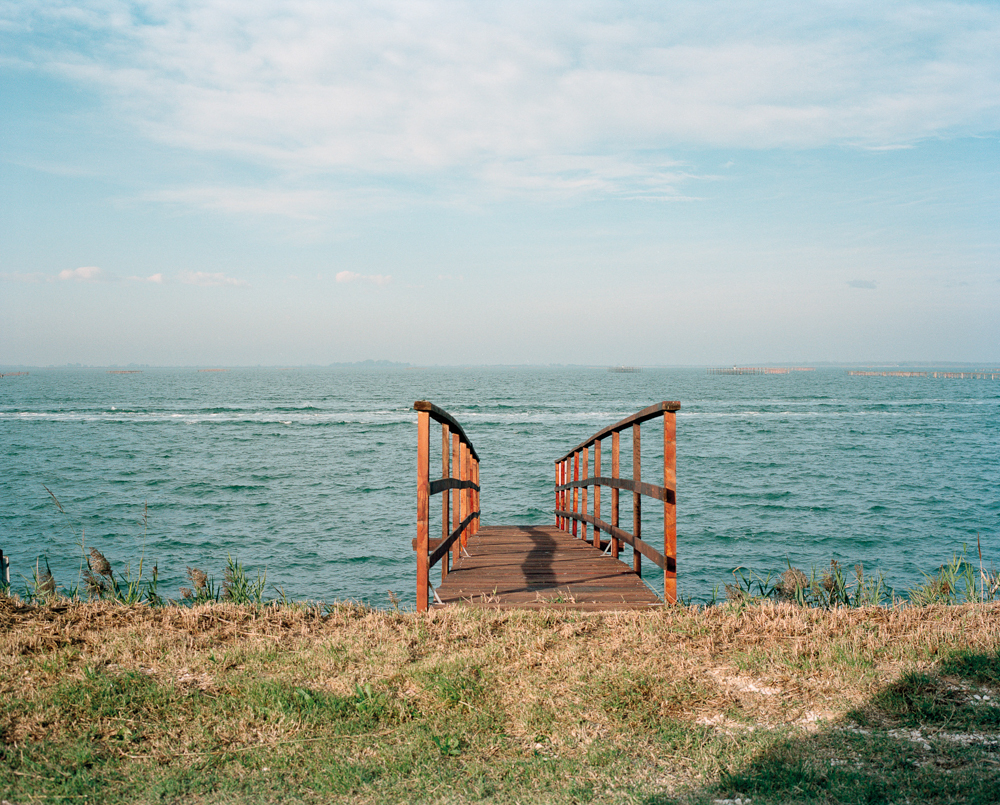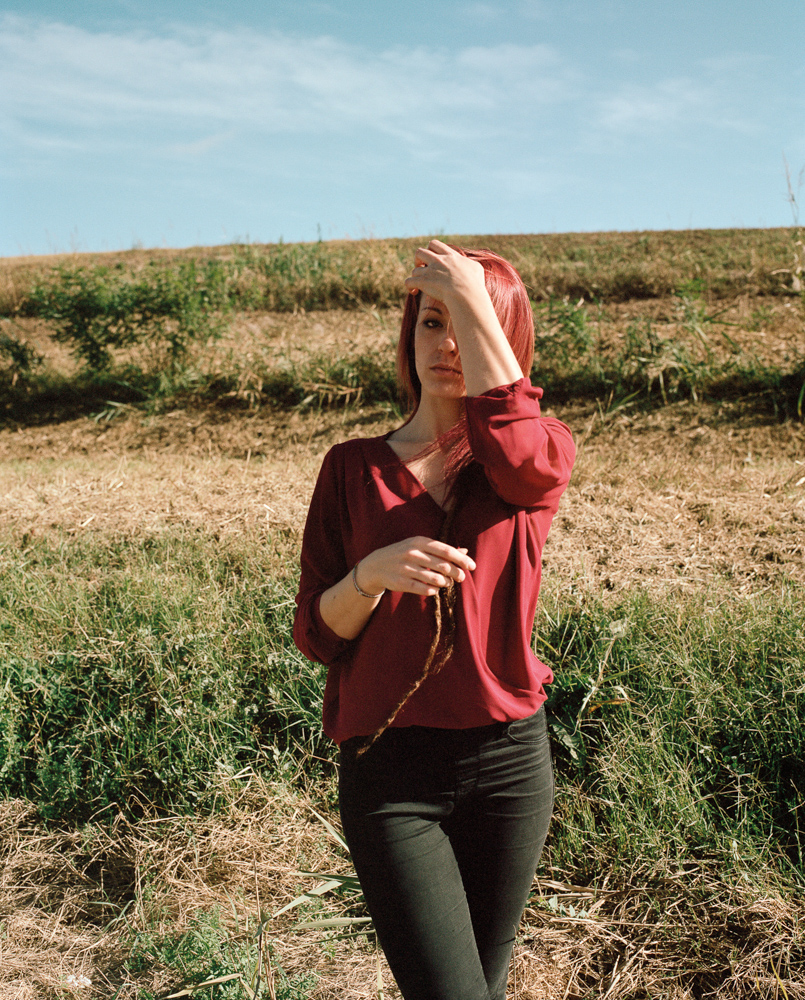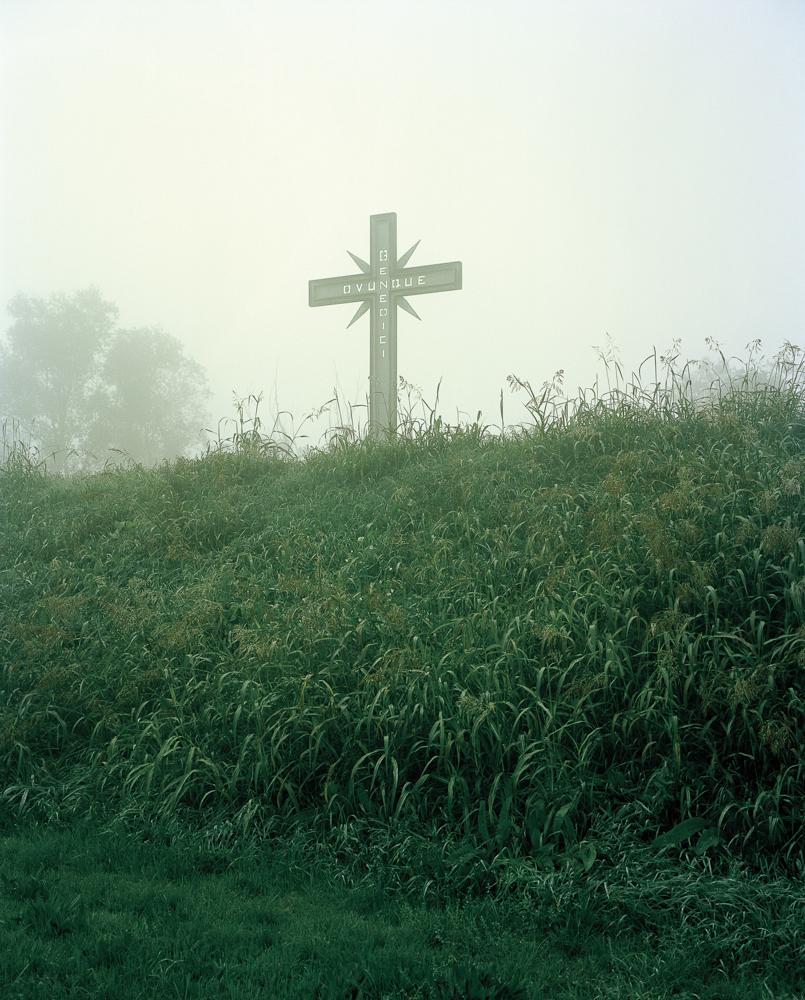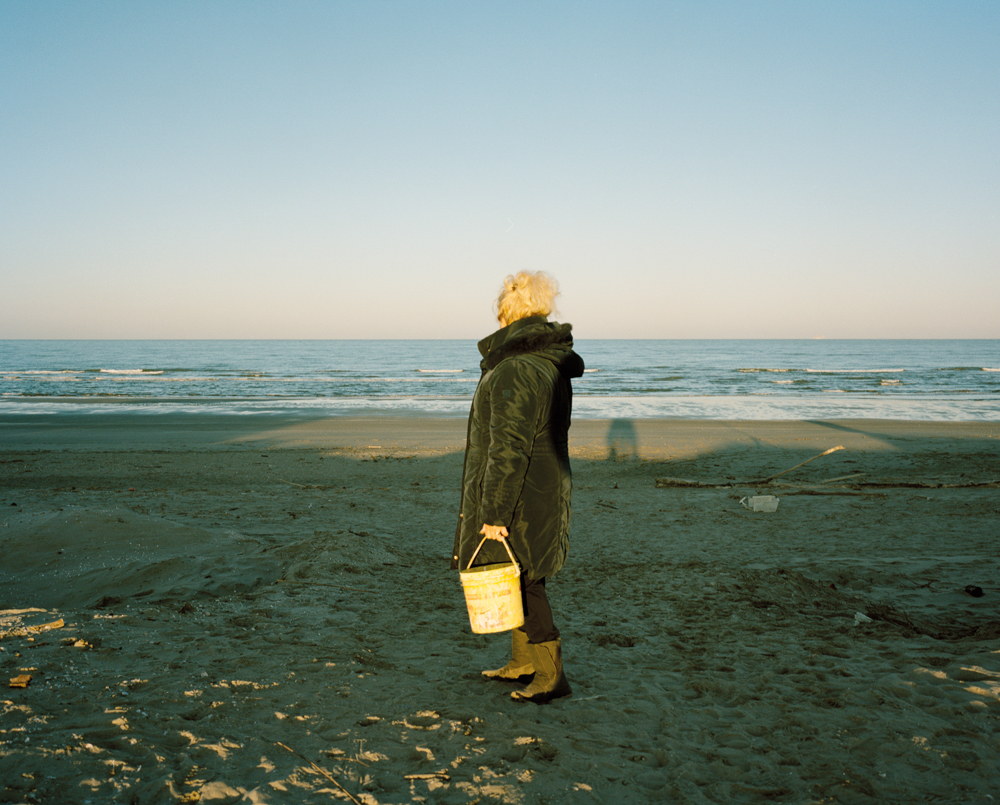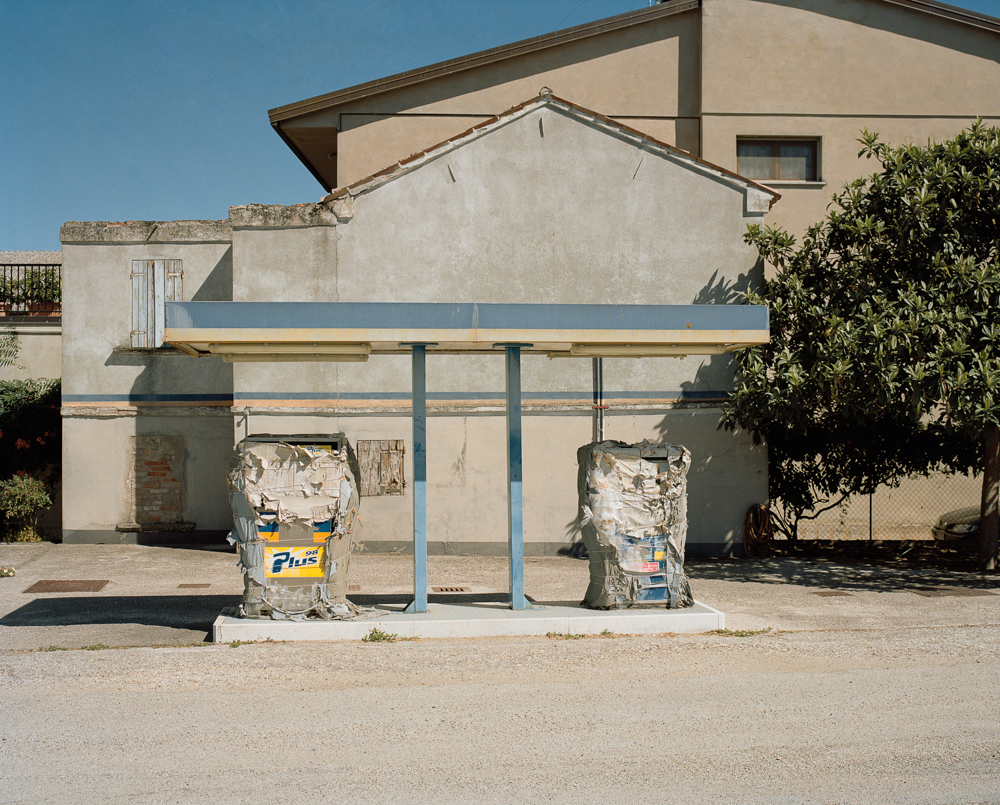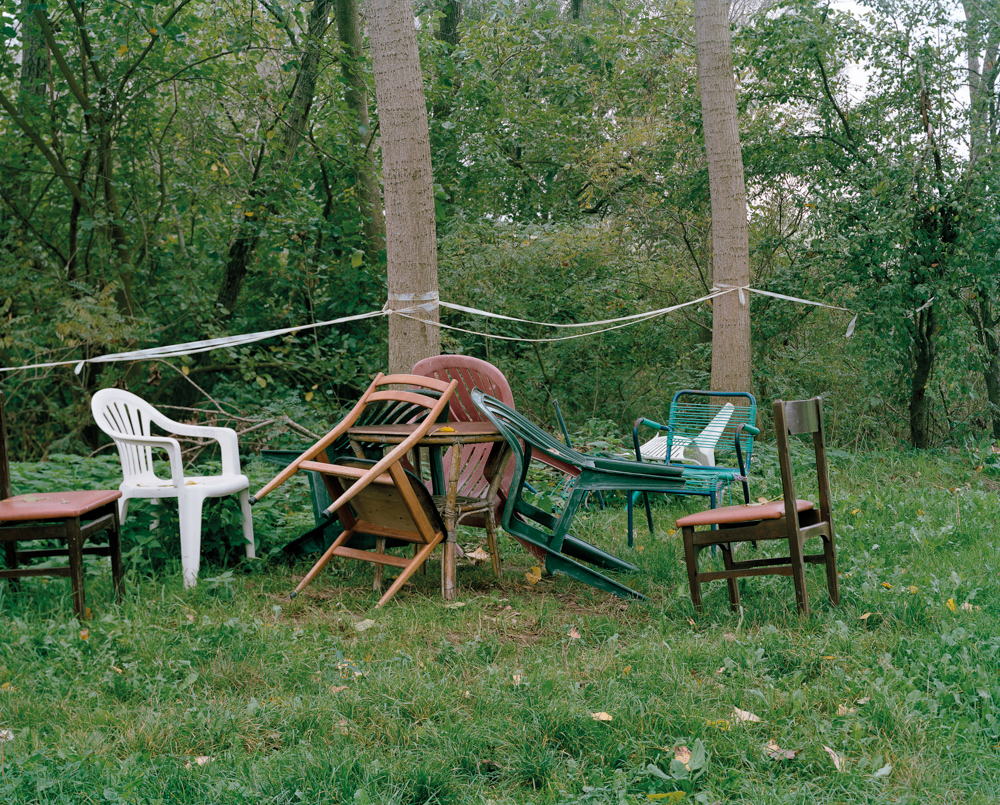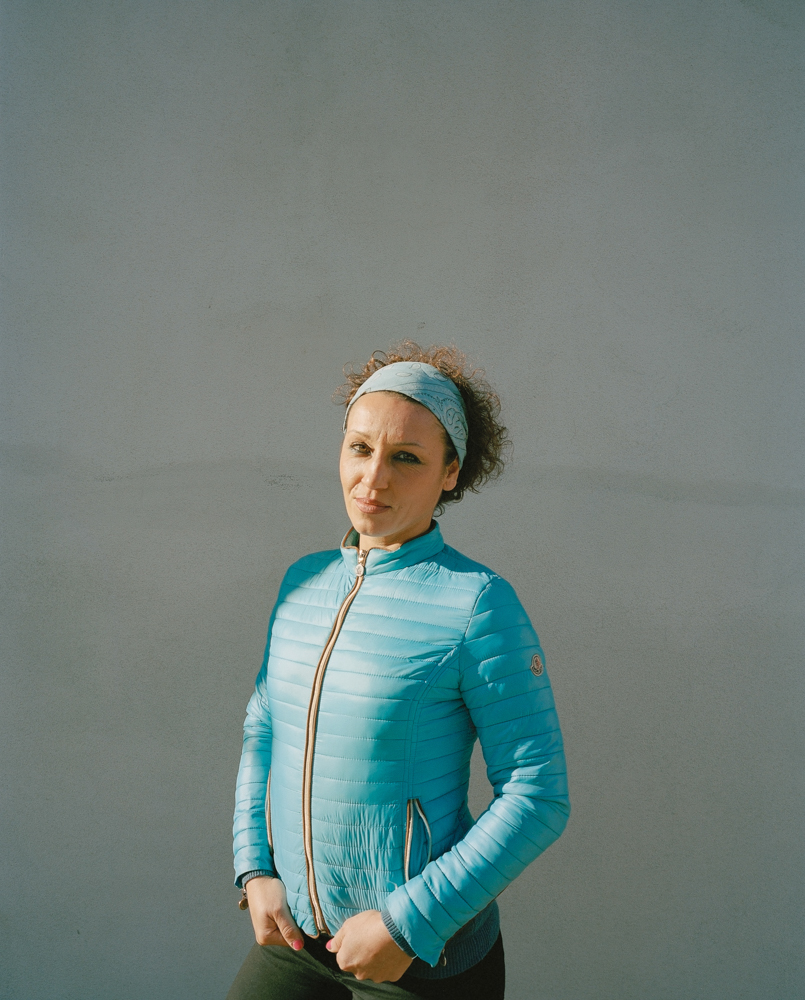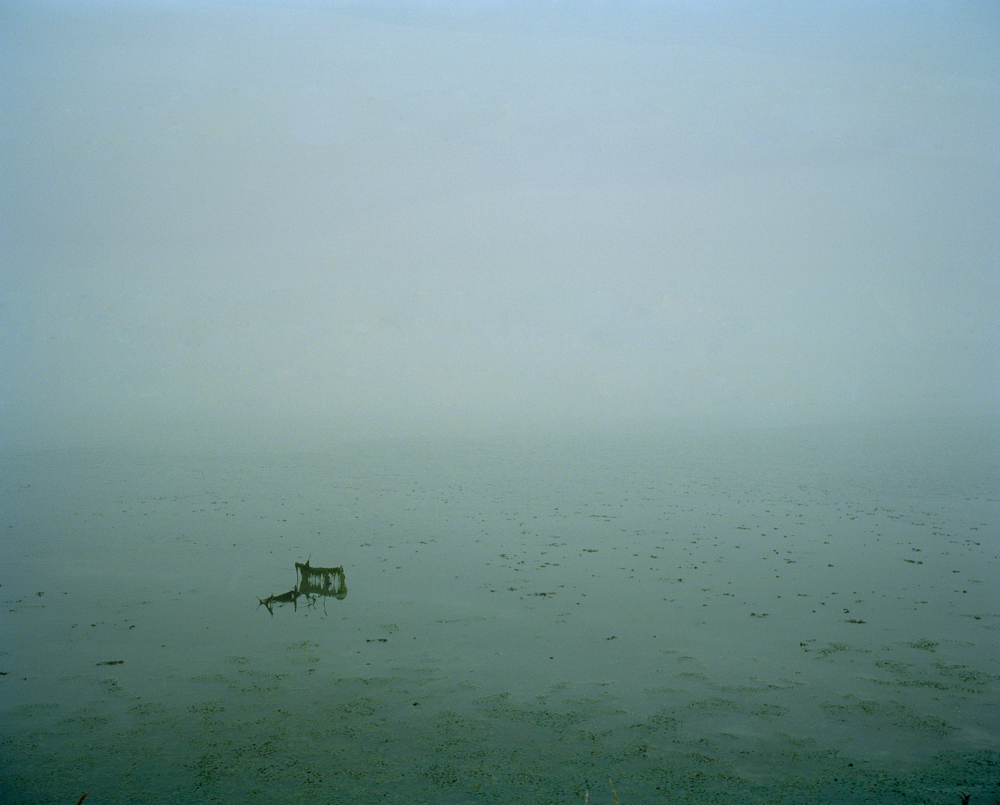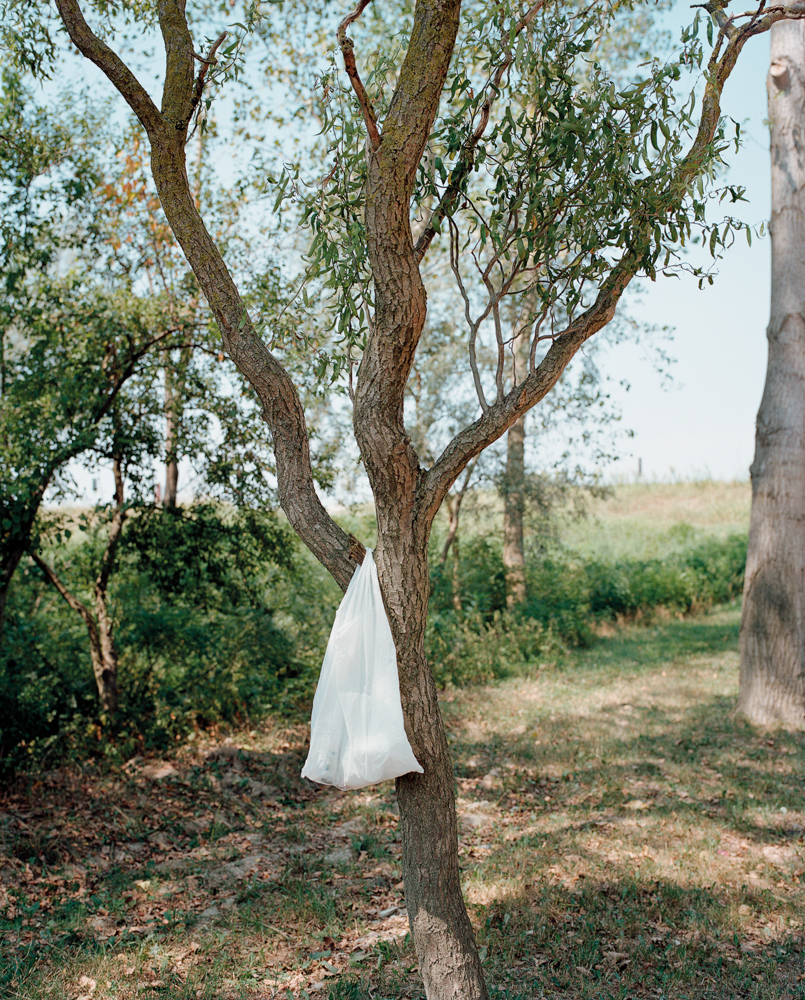Matteo Di Giovanni: Storytellers
The story of a human life is inherently circular. Centuries of non-existence gently curve into birth, self awareness, and the development of a singular identity only to meet the origin point of non-existence once again. Between these two points, our narratives vary vastly and yet this sort of homecoming is inevitable. Despite this knowledge, our lives are rife with uncertainty. Questions pertaining to identity, society, and the hereafter have long defined the human condition. Some turn to religious faith while others align themselves with a political ideology or scientific theory to quell the disquiet of day to day life. Milan based photographer Matteo Di Giovanni embraces the uncertain and places it as a central theme to his most recent work, titled, Blue Bar. In Blue Bar we see docks spilling out into the open ocean, a cross shrouded in fog rising from a sea of tall grass, and patterned curtains obscuring the outside world. The humans that sparsely populate these photographs exist in liminal, abstract spaces unmarked by geographic giveaways and cultural monoliths. The scenes are quiet and yet a sense of unease runs throughout the selection, a near silent undercurrent that reveals the unlikelihood of humankind and the precariousness of the society we’ve constructed. Within the scope of Di Giovanni’s work, Blue Bar is the transitional middle piece in a broader trilogy. The first chapter, titled, I Wish the World Was Even, dealt with testing limitations, while the final and forthcoming chapter, Traces, deals with returning home. How appropriate in this year of upheaval and irresolution that we find ourselves with Blue Bar, a body of work that while dedicated to uncertainty is not the end.
Born in Pescara in 1980, he gets a degree in Philosophy at La Sapienza University in Rome, where he starts working with photography. After the experience in the Italian capital, he moves to London, where he definitively begins to work as a photographer for magazines such as The Economist, Red Pepper, Slowfood Magazine, Hesamag among others. He also works as an assistant for Jeff Lipsky and Simon Roberts and they will both influence his way of working.
From 2010 he studies Photography at the Westminster University of London, where it achieves a Master of Arts in 2012 with a body of work about Bosnian national identity 20 years after the BalkanWar under the guidance of Max Houghton and David Campany. While working in Bosnia, he gets involved in a serious car accident, which affects and totally changes his perception of space. After a long rehabilitation, he moves to Milan, where he starts working on long-term projects related to landscape and human relation within the space. From that moment, he starts a close collaboration with Micamera, which allows the confrontation with authors such as Gus Powell, Tim Carpenter, Gerry Johansson and many others. These encounters offer him the chance to concentrate on more in-depth projects related to the landscape and our perception of it, the interaction between humans and space and the road-trip as gnoseological experience.
His first body of work, I wish the world was even, was published by Artphilein Editions in 2019. His second monograph, Blue Bar, has also been published by Artphilein Editions in September 2020. He is now working at the third series – Traces – which will conclude the trilogy.
A selection of these two books, including another body of work under development, will be exhibited altogether for the first time in a solo show at Robert Morat Galerie in Berlin in Fall 2022. His work is available through Robert Morat Galerie in Berlin.
Blue Bar
Traumatic events always change our perception of the world as well as the perception of our own self within the space. They set a “before” and “after” that cannot be avoided. In 2011 I got involved in a serious road accident while working in the Balkans on a project about Bosnian national identity and – since that moment – my life changed forever. I found myself at a crossroad. I had to choose between two options: give up photography or find a new way to use the medium in my new condition. I went straight for the second option, even though I was not sure I could keep on working as a photographer.
My first monograph “I Wish the World Was Even” is the result of the first road-trip I made after the crash. Two months on the road from Milan to the North Cape up in Norway, the northernmost point of continental Europe. I had to put myself into the condition – physical and psychological – to experiment the reactions of my body within the space surrounding me.
Editing that work has been revealing. I started thinking of photography as a deep metaphorical medium able to approach subjects such as fear, hope, passion, motivation; in one sentence, photography as a medium able to explore the human nature. From that moment, I moved from a photojournalistic perspective to a more documentary and art related way of presenting my photographs. This switch led me to focus primarily on book-making and gallery shows.
By slowing down the entire process, I shoot mostly with a 4×5 inch view camera, I have found my new way of approaching photography, working on very long, well researched and multi-layered projects. When I start working on a project, I always have in mind the end result, which is the book and all the exhibitions that will follow. The book form allows me – through sequencing and layout – to create alternative worlds in which the viewer can have his/her own experience and inference. I like the idea that a body of work can generate questions instead of giving answers. The exhibition is an alternative space where I can reassemble the work and give new meaning to it.
The whiteness of the gallery wall represents the starting point of a new interpretation of one or more bodies of work.
I don’t like to be defined as a landscape photographer, mainly because I don’t really like categories and constrained frames. Surely, I use the landscape as a metaphor to deal with more complex issues, following the tradition of the New American Photography and part of the Italian landscape movement. I rather define my photography as lyrical and poetic, since it always requires an action from the viewer.
This perspective is particularly visible in my second monograph, “Blue Bar”, which explores the idea of uncertainty in modern societies. The book, ironically, ended up being published between the two pandemic waves, which have brought the entire world in deep uncertain times. I can certainly state – connecting with what I have written at the beginning – that my way of working has radically changed after the accident and now deals with personal, social and anthropological issues focusing on the themes of memory, identity and human limitations using a precise approach to the medium.
In your statement you mention a serious car accident that altered your way of living and working. What did your approach to photography look like prior to the accident? What kind of projects were you involved in?
Before 2011, the year of the road accident, I was mainly working for small magazines and NGO prjects, which means I had to deliver the work quite quickly. At the same time, I was assisting different fashion photographers on location. That was the only way to make a living with photography for me. I was in London and everything was fairly expensive.
I wasn’t really happy of what I was doing, had no time to work on my projects and was always rushing around.
Then, in 2010, I was accepted at Westminster University under the guidance of Max Houghton and David Campany. I got involved in the crash when I was shooting the MA final project.
What led you to pursue a degree in philosophy? Now that you work photographically what philosophers influence your process? How so?
During my time in Rome, I was studying Communication Strategies. I enrolled for a Philosophy class and from there I changed all the plans. I felt I had found my dimension. Above all, it was the passion for the research that dragged towards philosophy.
I kept studying and my dissertation was on the relations between human beings and technology and how the human intervention changes the perception of space, following the path of German philosopher Günther Anders. I soon realized that the academic career wasn’t for me though, but everything I learned has become very precious.
Back to my photography, I would say it is also strictly connected to the relationship between humans and landscape, even though you don’t see people that often in my photographs. So, in a way, what I studied is present in my current research. Although, I consider it a starting point.
What is really important for me is that photography has one crucial thing in common with philosophy: it doesn’t give answers, it generates more questions. This means there’s not a single philosopher or a philosophical school who influence my work, but I share the same process of questioning reality as most philosophers (and photographers) do.
Your long-term projects are often built around a road trip. What about traveling this way inspires and drives your work? Do you ever shoot closer to home?
That’s a very good question. I will start from the end. I do have very hard time shooting in the place I live. Partly it’s for a practical reason, because it’s not always easy for me to split the day between shooting and doing everyday stuff.
The second reason is more general. When I photograph, I need to be focused on the work for a certain period of time, without distractions. For me it’s a very slow process, when I’m on location I can spend days without making photographs, I need to be immersed in the space I’ve decided to work within. Looking at it this way, the road trip becomes a gnoseological experience in which curiosity, knowledge, learning, encounters and discovery gather and mix all together.
That’s why I consider the road trip a key concept for my photography.
On the other hand, I’m trying to do some work on Milan, which is the city where I’ve based myself since 2014. I’m using this pandemic period to elaborate a series of photographs. Let’s see if I manage to get through it.
You state in your bio that your accident changed your perception of space. Could you elaborate on this?
When your condition changes in a split second, your body and brain are put under deep pressure, as they have to work on finding a new balance. The accident was quite harsh, I spent almost two full years in hospital before going through a long rehab and reported a permanent disability. I now wear a quite advanced technological prosthetic leg and for most people this wouldn’t be the perfect combination to pursue a career in photography, but I’m rather stubborn from this point of view and never wanted to give up.
That being said, having a mobility issue forces you to re-think the space around you. Things are completely different and the way you move around has to be re-learnt. Your brain has to work in a different way and there are many things we can’t do any longer. You’ve got to find a solution.
This brings you to perceive the space in a completely different way.
Blue Bar is the second installation in a greater trilogy. How does the narrative of this work intertwine with the prior publication I Wish the World Was Even and the forthcoming body Traces?
The first body of work – I Wish the World Was Even – was meant to be a personal test on if and how I could still work as a photographer. It was a way to evaluate my body within the space in a new condition.
My work tends to move around an idea, often it is just a word. I write that word on a sheet of paper and start making mental connections and then write them down.
In the case of Blue Bar, the word is “uncertainty”. Everything started from a conversation I had with a fisherman in one of my first trips to the Delta Region of the river. He told me that the existence of the valley itself, which lies underneath sea level, was strictly dependent to the recently constructed river banks. If they broke the whole valley would be submerged due to the floods. From there I started thinking about this idea in a broader way, how our lives are often dependent on micro-events that can radically change them.
It’s rather shocking that the book came out between the two pandemic waves that deeply hit Italy and most of the world. That wasn’t my initial idea, but that underlines the concept which is behind the book.
In the case of the first book, the main idea I wanted to investigate was “human limitations”.
The work I’m conducting now, which will be probably titled Traces, is around the idea of “home” and it will be about the region where I was born and where I was forced to get back for a year or so after the accident. That year made me look at that place in a completely different way. I had left my hometown in 1999, as it was a very anonymous place. These places where a 19-year-old guy sees no way to find what he is looking for.
The three bodies of work are surely connected by the idea of using landscape as a metaphor of a human condition, as the main themes surely come from a personal experience, but they can be thought as more universal aspects of human life.
They altogether form a sort of circle, which I hope it will the fundament of my future work.
How did making images of the landscape become your vehicle for poetry and storytelling?
I became being interested in this kind of photographic approach when I was at the college and discovered the American and British tradition of landscape photographers. Of course, I knew these photographers already, but David Campany’s classes made me see them from a completely different point of view.
It seems to be easy, but the moment you realize that a landscape photograph is not just a description of a place, but can be something way more universal is when your brain starts working in an opposite way.
I had started to work on the landscape during my MA final project, which was never properly ended for the reasons you can imagine.
When I realized I was able to get back to photography, I started again from where I left. The more I’ve worked on it, the more I’ve realized that using the landscape as a metaphor is a very powerful tool. Although, the real switch has been a workshop I did with Gus Powell at Micamera in Milan. His book, The Lonely Ones, together with the conversations we had during and after that workshop, have been crucial for the editing of my first book and, consequentially, all the work that has come since then. I owe Gus a lot.
That book is the perfect mixture of photographs and texts, which becomes poetry.
On top of that, observing has become the most important activity for me. I’m not sure, but it may be coming from the idea that I don’t give anything for granted any longer.
Anything else you’d like to add?
Yes, these questions have given me very hard time, because they have forced me to go through the past five years of my photography in a way I had never done before. And that’s great. Really hope the answers are satisfying.
Posts on Lenscratch may not be reproduced without the permission of the Lenscratch staff and the photographer.
Recommended
-
Paccarik Orue: El MuquiDecember 9th, 2025
-
Lauri Gaffin: Moving Still: A Cinematic Life Frame-by-FrameDecember 4th, 2025
-
Dani Tranchesi: Ordinary MiraclesNovember 30th, 2025
-
Art of Documentary Photography: Elliot RossOctober 30th, 2025
-
The Art of Documentary Photography: Carol GuzyOctober 29th, 2025



